Raise your gardening game with creative bed ideas! These structures offer many benefits for all gardeners. They improve soil control and make maintenance easier, transforming backyards across America.
Discover garden bed designs for various styles and spaces. There’s an option for every gardener, from DIY to ready-made solutions. Let’s explore ideas that will revitalize your outdoor space.
Raised beds come in diverse shapes and sizes. They range from wooden rectangles to modern galvanized troughs. You can repurpose items like pallets or storage bins for budget-friendly options.
For limited spaces, vertical gardens and triangular beds offer smart solutions. These designs help maximize your growing potential. They’re perfect for small yards or balconies.
Materials affect both looks and durability. Cedar and rot-resistant woods are popular but pricey. Budget-friendly gardeners might choose concrete blocks, costing $1.50 to $5 each.
Upcycled materials like rocks and logs create a natural look. They’re eco-friendly and can be free if found locally. These options add unique character to your garden.
Key Takeaways
- Raised garden beds improve soil drainage and plant accessibility
- DIY options range from upcycled materials to purchased kits
- Various materials suit different budgets and aesthetic preferences
- Unique designs like triangular beds can optimize small spaces
- Incorporating lighting extends garden enjoyment into evening hours
- Raised beds are suitable for growing vegetables, herbs, and flowers
- 85% of gardeners find square foot gardening effective for maximizing growth
Understanding the Benefits of Raised Garden Beds
Raised bed gardening offers many advantages for all gardeners. It’s an innovative approach that’s gaining popularity. This method provides efficient and low-maintenance gardening solutions.
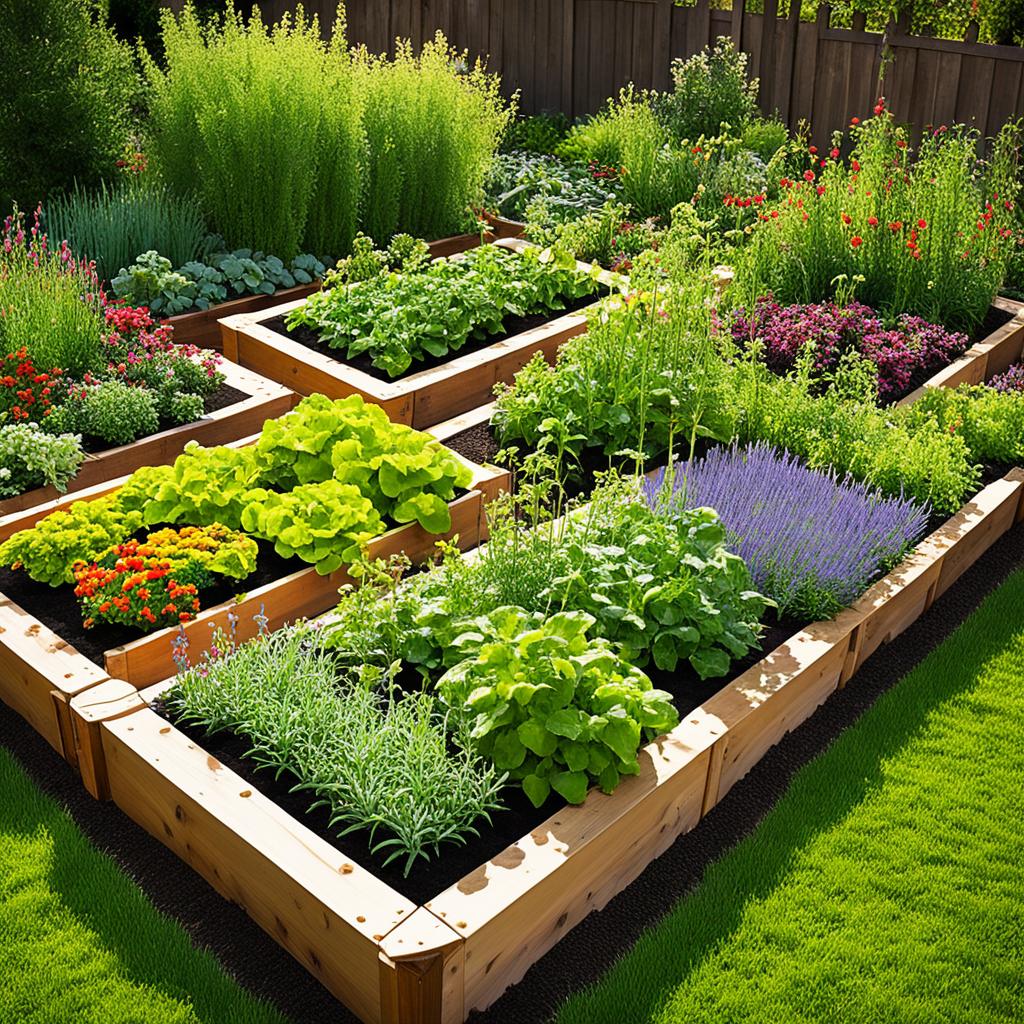
Improved Soil Drainage and Control
Elevated garden beds allow superior soil management. Gardeners can customize soil mixtures for specific plants. This ensures optimal growing conditions for each plant.
A study at Dawes Arboretum found impressive results. Harvests from raised beds nearly doubled per square foot compared to traditional gardens.
- Soil warms up faster in spring, allowing earlier planting
- Better drainage prevents waterlogging and root rot
- Loose, friable soil promotes healthy root development
Easy Access and Maintenance
Raised bed gardening enhances accessibility for all gardeners. The elevated design reduces physical strain during planting and harvesting. It’s an ideal choice for gardeners of all abilities.
- Customizable height for comfortable gardening (18 inches recommended)
- Ideal for small spaces like patios or driveways
- Allows for dense planting, increasing yields in limited areas
Pest and Weed Management
Elevated garden beds offer effective strategies for organic gardening. They create a controlled environment for natural pest prevention. This design also helps reduce weed growth.
- Dense planting limits weed proliferation
- Raised design deters some ground-dwelling pests
- Easier to install protective measures like fencing or mesh
Raised bed gardening can boost your garden’s productivity and accessibility. It promotes healthier plants and increased yields. This approach reduces the need for chemicals, aligning with organic gardening principles.
Materials for Building Raised Garden Beds

Picking the right materials is key for a thriving raised garden. Wood, metal, and concrete are popular choices. Each option has its own perks for garden bed building.
Wooden Raised Garden Beds
Wood is a top pick for raised garden beds. Cedar, hemlock, and redwood resist rot naturally. These woods are safe for growing food and last long.
- Cedar: Lasts 10-15 years
- Hemlock: Affordable option, lasts 6-8 years
- Redwood: Premium choice, can last 20+ years
Skip pressure-treated lumber for food gardens. If you must use it, let it dry for six months. Use stainless steel or galvanized screws with it.
Metal Raised Garden Beds
Galvanized steel is becoming a popular choice. It’s strong, fights rust, and gives gardens a modern look. With good care, metal beds can last for decades.
Concrete and Stone Options
Concrete blocks and bricks make sturdy, long-lasting beds. They work great on slopes and offer a permanent solution. These materials are perfect for gardens meant to last.
Raised Bed Soil Mix
The right soil mix is crucial for your garden’s success. A good mix usually includes:
| Component | Percentage | Purpose |
|---|---|---|
| Topsoil | 60% | Base material |
| Compost | 30% | Nutrient-rich organic matter |
| Perlite or Vermiculite | 10% | Improves drainage |
This blend feeds plants, keeps moisture, and helps water drain well. A bed at least 6 inches high gives roots space to grow. It also makes gardening easier on your back.
DIY Raised Garden Bed Projects
Making your own raised garden beds is fun and rewarding. You can save money and reuse items you already have. This adds a personal touch to your garden and reduces waste.
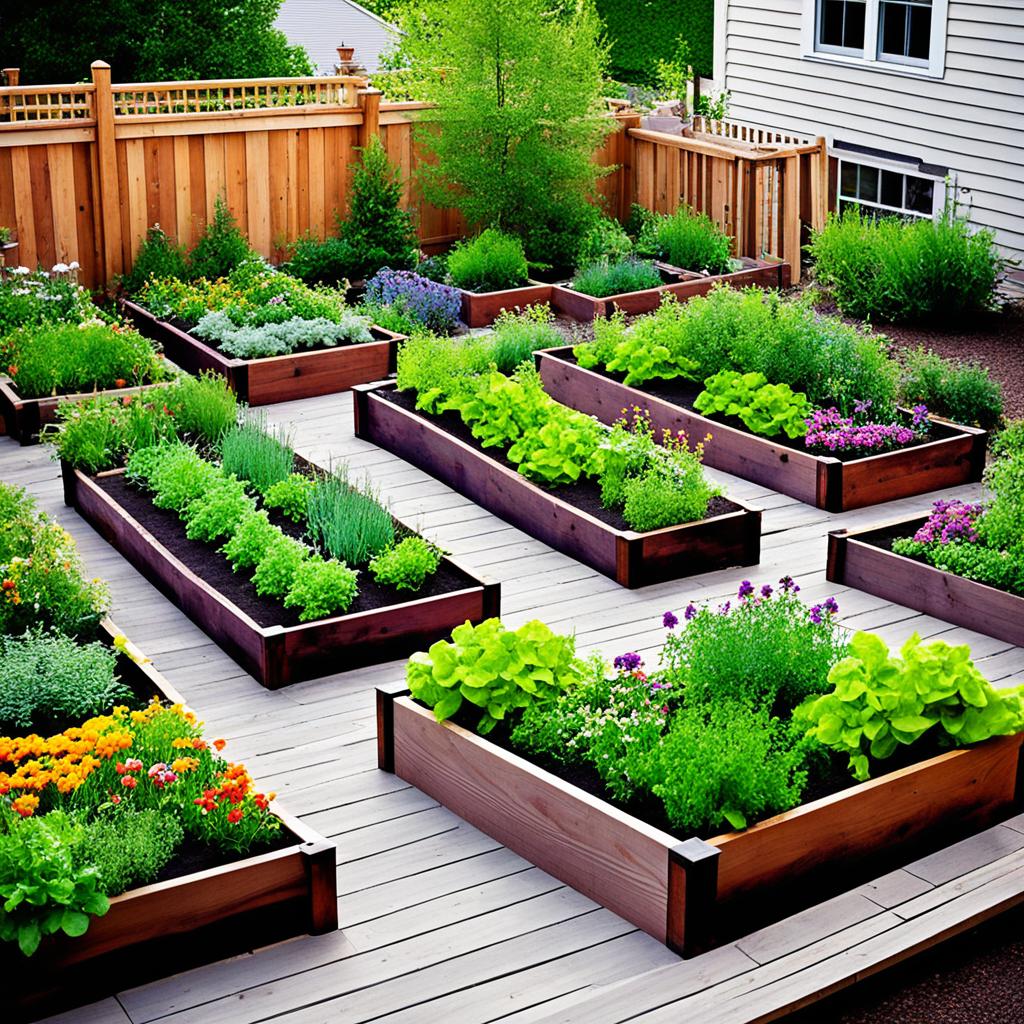
Upcycled Bookcase Garden
Turn an old bookcase into a unique garden bed. This idea gives new life to forgotten furniture. It’s a creative way to start container gardening.
Here’s how to make your upcycled garden bed:
- Remove any backing from the bookcase
- Drill drainage holes in each shelf
- Line shelves with landscape fabric
- Fill with high-quality potting soil
- Plant your favorite herbs or flowers
Wooden Pallet Vertical Garden
Wooden pallets are great for vertical gardening. This saves space in small yards or balconies. Follow these steps to create your pallet garden:
- Clean and sand the pallet
- Staple landscape fabric to the back and bottom
- Create pockets for plants using the fabric
- Fill pockets with soil and add plants
- Secure the pallet to a wall or fence
Repurposed Table Planter
Turn an old table into a charming raised garden bed. This project combines style with function. It creates a talking point in your yard.
Here’s how to make it:
- Remove the tabletop
- Line the table frame with landscape fabric
- Add a layer of gravel for drainage
- Fill with soil and plant your favorites
These DIY raised garden beds can be built for under $50 each, making them an affordable option for any gardener.
| Project | Difficulty | Time to Complete | Cost |
|---|---|---|---|
| Bookcase Garden | Easy | 2-3 hours | $20-$30 |
| Pallet Vertical Garden | Moderate | 4-5 hours | $15-$25 |
| Table Planter | Easy | 1-2 hours | $10-$20 |
These DIY raised garden beds offer unique solutions for all gardeners. You can create beautiful spaces to grow plants by upcycling everyday items. This adds character to your outdoor area.
Natural Material Raised Garden Bed Ideas
Natural raised beds blend beauty and function in your garden. They enhance outdoor spaces and support eco-friendly gardening. Let’s explore some inspiring ideas for raised beds using natural materials.

Log raised beds offer rustic charm and durability. Fallen trees can be repurposed into sturdy bed frames. These frames enrich the soil as they decompose over time.
A 4′ x 8′ log raised bed can be built with untreated cedar boards. Cedar is known for its rot-resistant properties.
Stone garden beds provide a permanent and visually appealing option. Large rocks or stones can outline beds, blending with the landscape. These beds work best in areas with 6-8 hours of daily sunlight.
- Use locally sourced materials for a truly sustainable approach
- Combine different natural materials for unique designs
- Consider the depth of your beds based on plant needs
Woven branch designs create unique, biodegradable bed frames. This method is cost-effective and aligns with sustainable gardening principles. Natural materials like bricks, stones, and reclaimed wood make beautiful, budget-friendly raised beds.
“Natural raised beds not only enhance the aesthetic appeal of your garden but also contribute to a healthier ecosystem.”
Consider these practical aspects when planning your natural raised beds:
| Aspect | Recommendation |
|---|---|
| Bed Size | 3-4 feet wide by 6-8 feet long |
| Sunlight | 6-8 hours daily |
| Soil Bottom | Open for better root growth |
| Material Longevity | Cedar lasts 20+ years |
Natural material raised beds create beautiful garden spaces. They also promote sustainable, eco-friendly gardening. As materials like logs decompose, they enrich the soil naturally.
This process leads to healthier plant growth. It also reduces the need for additional fertilizers.
Brick and Stone Raised Garden Beds
Brick and stone raised beds offer durability and visual appeal. They enhance your garden’s look and help plants grow better. These sturdy options are practical and attractive for outdoor spaces.
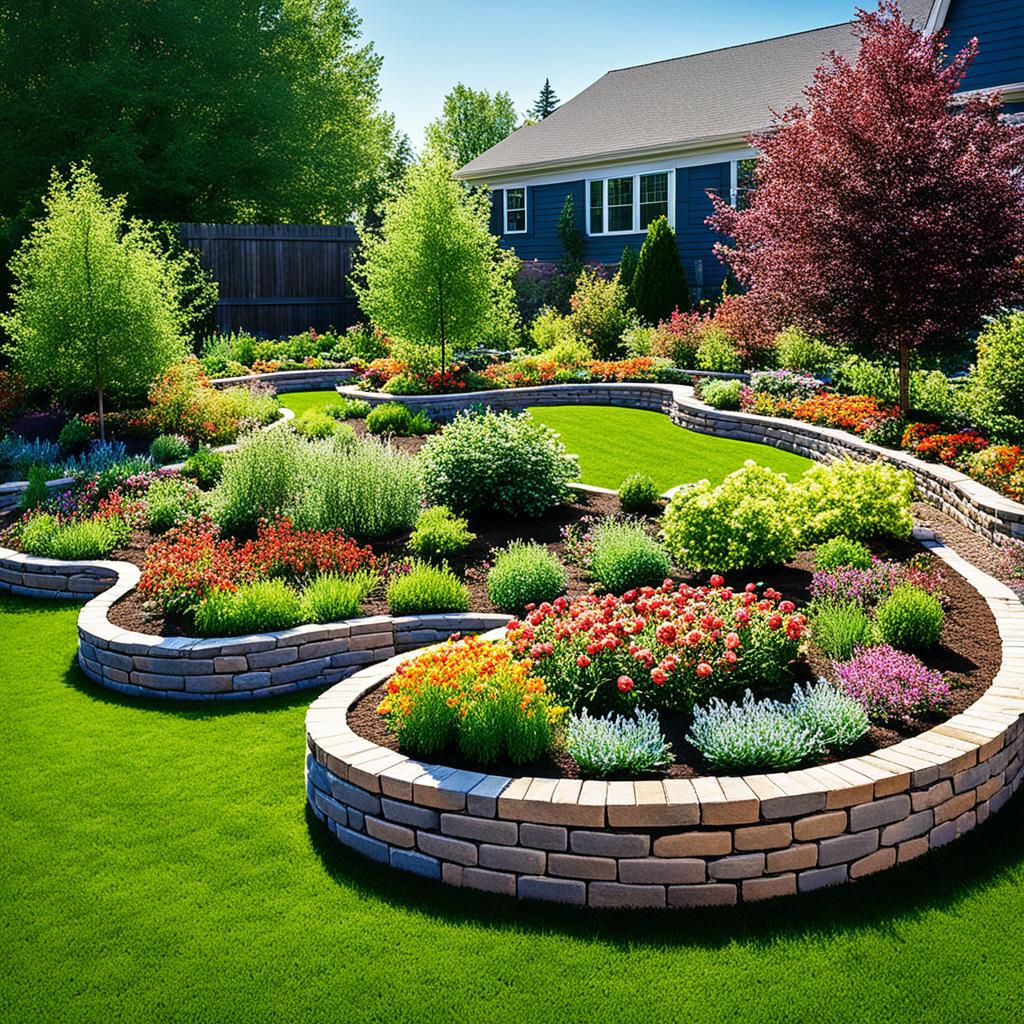
Stacked Brick Food Bank Design
A stacked brick design creates a unique food bank in your yard. This multi-level approach maximizes space for creative gardening. Brick beds retain heat well, extending the growing season for warmth-loving plants.
Concrete Block Garden Beds
Concrete block gardens are affordable and customizable for raised beds. These structures allow planting in block holes, increasing growing area. A basic raised bed with concrete blocks can cost under $50.
- Use Oldcastle planter wall blocks at about $3 each
- Require only four blocks and four lengths of lumber
- Easy to construct and modify
Paving Stone Raised Beds
Paving stone gardens are flexible and easy to assemble. They suit various landscape styles and can be adjusted as needed. Like brick and concrete, paving stones offer excellent heat retention.
| Material | Cost Range (4×4 ft bed) | Durability | Ease of Assembly |
|---|---|---|---|
| Brick | $200-$400 | High | Moderate |
| Stone | $300-$600 | Very High | Moderate |
| Concrete Blocks | $50-$100 | High | Easy |
| Paving Stones | $150-$300 | High | Easy |
Consider cost, durability, and ease of assembly when choosing raised bed materials. Brick and stone beds have higher costs but offer lasting beauty. Concrete blocks are cheap and flexible.
Paving stone gardens balance looks and practicality. Each material has unique benefits for your garden needs.
“Raised-bed gardening allows for creating a customized soil mix from scratch and avoids obstacles like rocks and roots.”
Raised garden beds improve soil drainage and make maintenance easier. They also help manage pests better. These beds work well in areas with poor soil or limited space.
Unique Shapes and Designs for Raised Garden Beds
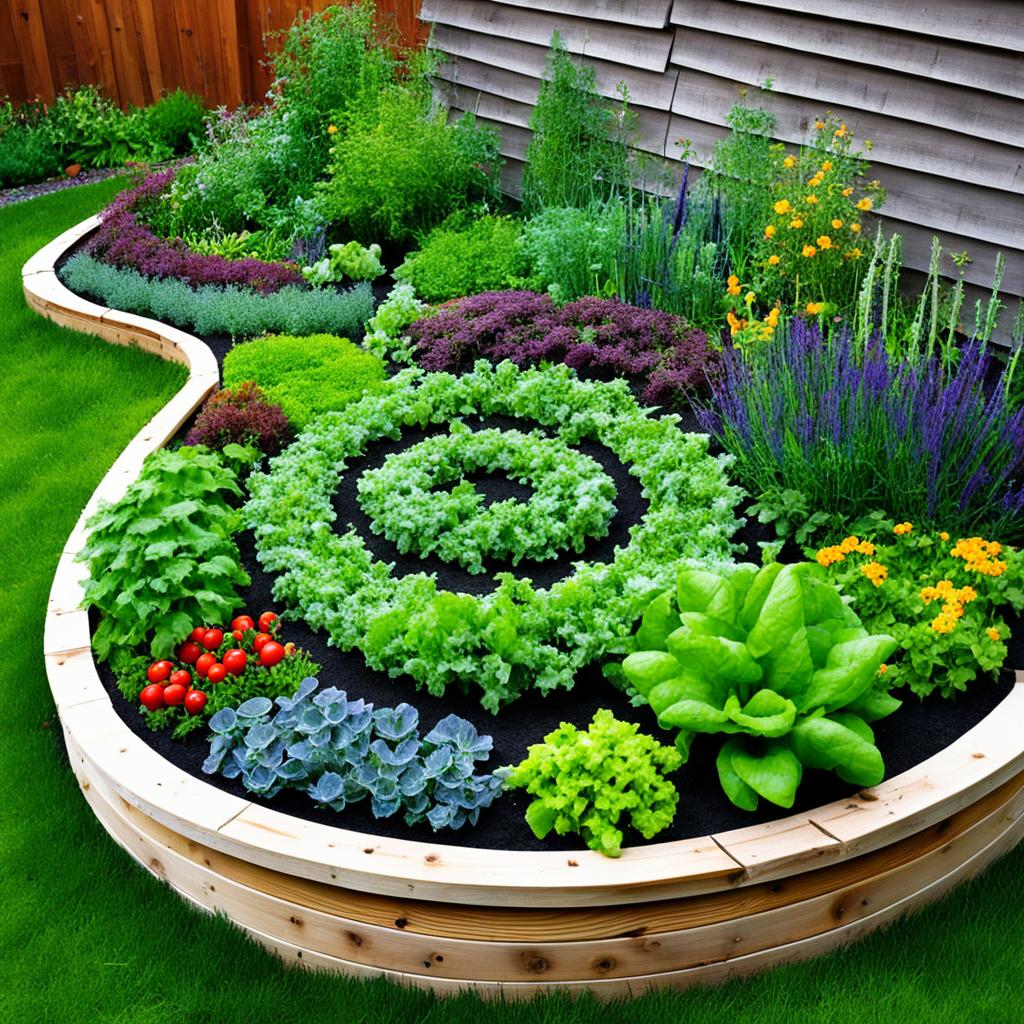
Gardeners love creative raised bed designs for visual interest and space efficiency. These beds boost plant growth and make gardening easier. Let’s look at some cool ideas for your next garden project.
Triangular raised beds save space and look great. They fit well in corners and odd areas. These beds can boost planting space by 15% compared to regular rectangles.
Hexagonal planters offer a bold look. These six-sided beds create wider planting areas. They also form eye-catching patterns when grouped together.
Gardeners find hexagonal beds great for organizing plants. They also allow easy access from all sides.
- Tiered designs: Perfect for sloped areas
- Curved beds: Add a softer, more natural look
- Spiral designs: Ideal for herb gardens
- L-shaped beds: Maximize corner spaces
When planning your raised bed designs, consider these stats:
| Design Feature | Benefit | Recommendation |
|---|---|---|
| Bed Width | Easy access without stepping in | 3-4 feet |
| Sun Exposure | Optimal plant growth | 6-8 hours daily |
| Height Variation | Visual appeal and depth | Mix of low and high beds |
| Material | Longevity and aesthetics | Cedar or rot-resistant wood |
Unique raised bed designs can turn your garden into a stunning outdoor space. Try triangular beds, hexagonal planters, or other creative shapes. Your garden will look amazing and produce great harvests.
“The garden suggests there might be a place where we can meet nature halfway.” – Michael Pollan
Galvanized Trough Gardens: A Rustic-Elegant Solution
Galvanized raised beds blend rustic charm and practicality for your garden. These trough gardens are durable, stylish, and ready to use. Let’s explore their benefits and pest prevention techniques.

Benefits of Using Galvanized Troughs
Galvanized troughs offer several advantages to your garden design:
- Durability: Resistant to rot and weather damage
- Versatility: Available in various sizes for different plants
- Early planting: Heat up quickly in spring, extending the growing season
- Space-efficient: Ideal for small gardens or urban settings
- Low maintenance: Require minimal upkeep
These trough gardens fit perfectly with rustic garden designs. They add countryside charm to any outdoor space.
They’re great for areas with poor soil quality. You have full control over the growing medium.
Pest Prevention Techniques
Creating pest-resistant gardens is vital for thriving plants. Here are some effective strategies for your galvanized raised beds:
- Line the bottom with galvanized hardware cloth to deter burrowing animals
- Plant pest-repelling herbs like lavender around the edges
- Use companion planting techniques to naturally ward off insects
- Incorporate netting or mesh covers for additional protection
- Maintain proper plant spacing to improve air circulation
These techniques help keep unwanted visitors away. You’ll enjoy the beauty of your trough gardens.
A well-planned garden leads to a bountiful harvest. It also creates a picturesque outdoor space.
| Feature | Benefit |
|---|---|
| Elevated design | Easier access, less bending |
| Controlled soil environment | Improved plant growth |
| Modular setup | Flexible garden layout |
| Heat retention | Extended growing season |
Galvanized trough gardens offer rustic elegance for your outdoor space. They’re perfect for both new and experienced gardeners.
These versatile containers can transform your yard. Create a productive and visually appealing haven with trough gardens.
Raised Garden Bed Ideas for Small Spaces
Urban gardeners often face space limitations. But small raised garden beds can turn tiny areas into lush green spaces. With smart design, you can grow food in compact urban settings.
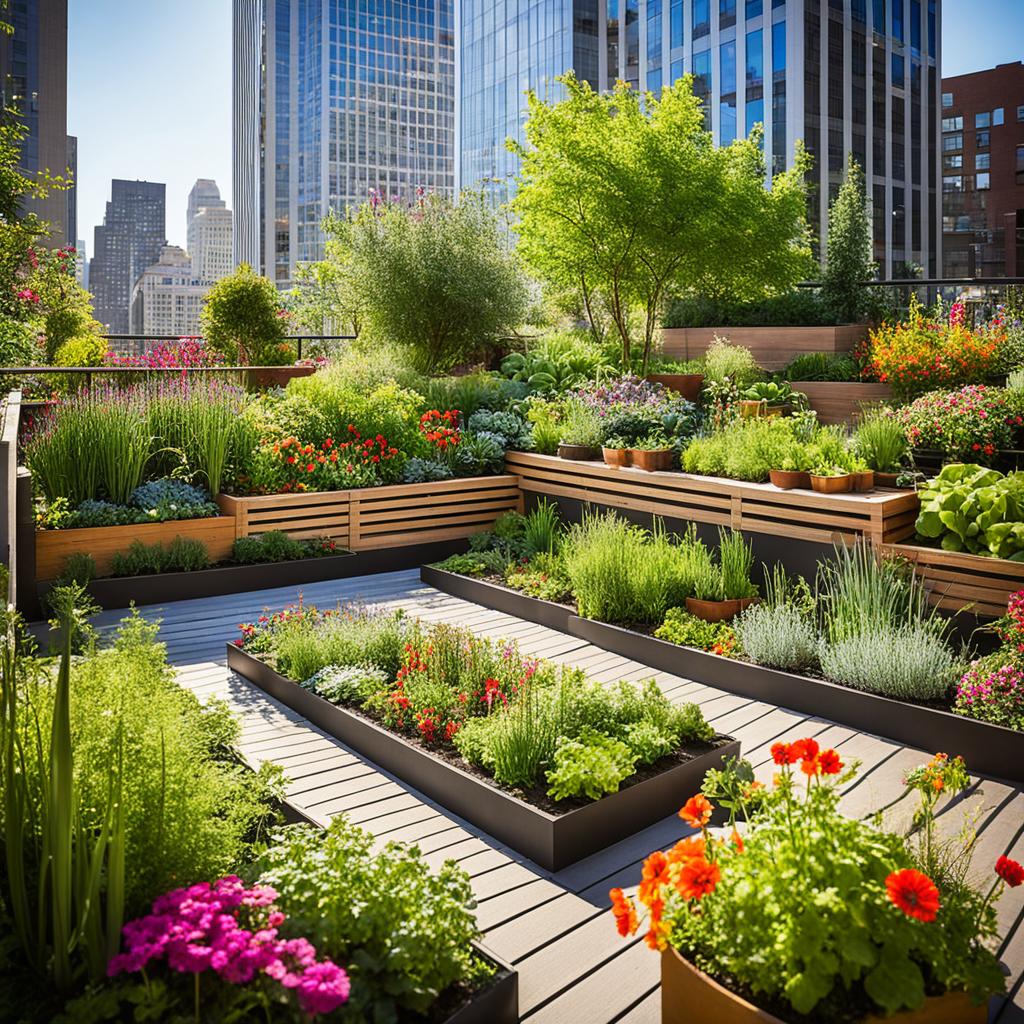
Space-saving techniques help maximize yield in small areas. Here are some clever ideas for small raised garden beds:
- Vertical gardening solutions
- Tiered planters
- Window boxes
- Balcony planters
- Multi-level beds
- Hanging planters
- Wall-mounted systems
These options let you grow various plants without using much floor space. Six 4’x12′ raised beds can host a diverse veggie garden in a small yard.
“Growing vegetables you enjoy eating is key to maintaining a successful small space garden.”
Consider these tips for your urban garden:
- Choose dwarf or compact plant varieties suited for container growing
- Utilize companion planting to maximize space and reduce pests
- Incorporate herbs and flowers for pest protection and decoration
- Plan your planting timeline based on your specific hardiness zone
Here’s a sample planting plan for your small raised garden beds:
| Bed Number | Plants | Purpose |
|---|---|---|
| 1 | Peas, Cucumbers, Marigolds | Vegetables and pest control |
| 2 | Greens, Radish, Beets, Onions | Salad bar foundation |
| 3 | Strawberries, Cilantro, Basil | Fruits and herbs |
| 4 | Carrots, Green Onions, Broccoli, Green Beans | Mixed vegetables |
| 5 | Cherry Tomatoes, Bell Peppers, Jalapenos | Nightshade family |
| 6 | Cut Flowers | Decoration |
Successful space-saving gardening requires observation and adaptation. Keep notes on what works best in your small beds. Adjust your plan each season for the best results.
Incorporating Trellises and Supports in Raised Beds
Garden trellises and supports can transform your raised beds. They maximize space, boost yields, and add visual appeal. Let’s explore how to integrate these structures into your garden.
Teepee-Shaped Trellises
Teepee trellises are ideal for vining plants like beans and cucumbers. They’re simple to build and add charm to your garden. Here’s how to make one:
- Gather 3-4 long bamboo poles or wooden stakes
- Tie the tops together with sturdy twine
- Spread the bottoms in a circle and push into the soil
- Wrap twine around the poles to create a climbing surface
These structures support plants as they grow upward. They keep fruits off the ground and make harvesting easier.
Arch Entryways for Vining Plants
Arch garden designs are both beautiful and functional. They serve as entryways while supporting vigorous climbers like gourds and melons.
“Arch trellises transform raised beds into enchanting garden rooms, creating natural divisions and focal points.”
To add an arch trellis to your garden:
- Install metal or wooden posts at each end of your raised bed
- Attach a curved top piece to form the arch
- Add wire mesh or twine for plants to climb
- Plant vining crops at the base of each post
Your plants will create a living canopy as they grow. This adds depth and interest to your garden space.
| Trellis Type | Best For | Material Options |
|---|---|---|
| Teepee | Beans, Peas, Cucumbers | Bamboo, Wood |
| Arch | Gourds, Melons, Flowering Vines | Metal, Wood |
| A-Frame | Tomatoes, Squash | Wood, PVC |
Vertical gardening elements create a dynamic and productive raised bed garden. Trellises support your plants and add architectural interest. They turn your garden into a true outdoor sanctuary.
Lighting and Decor for Raised Garden Beds
Elevate your raised garden beds with smart lighting and outdoor decor. String lights can turn your garden into a magical evening retreat. Drape them along fences or hang them above beds for a cozy nighttime ambiance.
Solar-powered stake lights are great for illuminating pathways between beds. They enhance safety and add beauty to your garden. These lights are easy to install and maintain.
Add charm to your garden with decorative elements that show your style. Garden art, colorful planters, or painted bed frames can boost your space’s character. Olive Land LLC’s garden features custom stonework and metal sculptures for inspiration.
Consider adding seating areas near your raised beds. Kate Gould Gardens’ design showcases inviting spaces for relaxation and garden enjoyment. This creates a perfect spot to appreciate your hard work.
Plan your garden lighting to go beyond basic function. Use lights to highlight focal points or create interesting shadows. Mix different types of lighting for a layered effect.
With the right combination of lighting and decor, your garden becomes a stunning outdoor space. It will be enjoyable both day and night, turning into your personal oasis.
